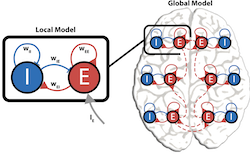Abstract
The brain is a complex, nonlinear system, exhibiting ever-evolving patterns of activities even without external inputs or tasks. Such intrinsic or resting neural dynamics has been found to play critical roles in the normal functioning of the brain and psychiatric disorders. It remains a challenge, however, to link the intrinsic dynamics to the underlying structure, in part, due to the nonlinearity. Here we use a nonlinear-dynamical model to examine how the complexity of intrinsic neural dynamics, in terms of multistability and temporal diversity, is sculpted by structural properties across scales. Our model combines a population-level model (Wilson-Cowan) with additional biophysical constraints (from the reduced Wong-Wang model). We show that multistability can emerge at the whole-brain level even when individual brain regions are by themselves monostable. The multi-functionality and memory capacity associated with multistability are thus synergistic properties of the whole-brain, irreducible to properties of its parts. The exact size of the functional repertoire and memory capacity is a joint product of the nonlinearity in the local dynamics and the topology of the large-scale network. Similarly, temporal diversity of the brain is determined by both local structural differences and the topology of the global network. Together, this work unravels an intertwined and circular relationship between local and global properties in defining the intrinsic dynamic organization of the brain. Looking forward, the model can be used to probe the multiscale mechanisms underlying psychiatric disorders and the effective scales for treatment.
